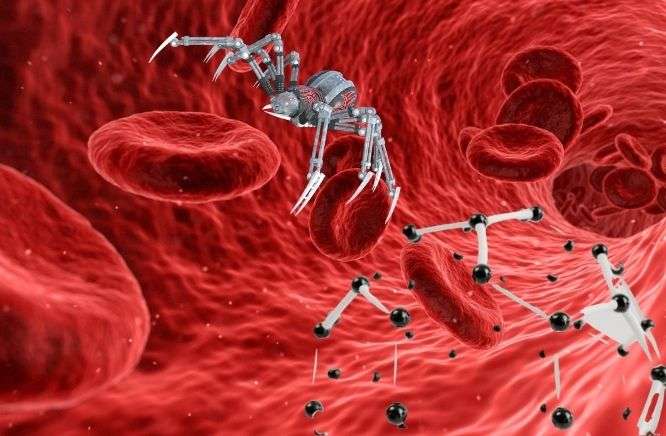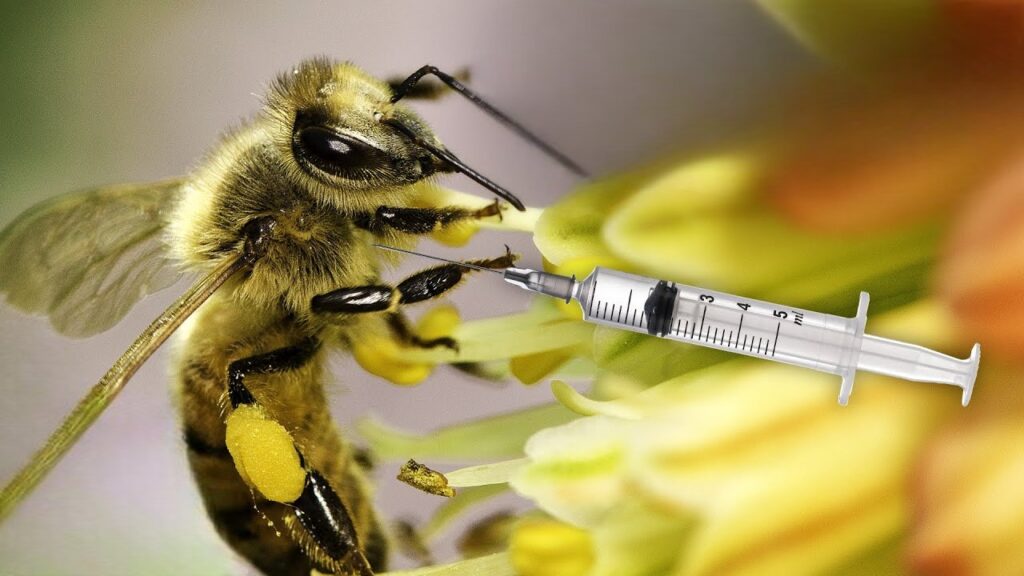
Yes, Nanotech can be injected directly into our bloodstream by the help of very small Nanobots.
They can also enter our bodies by passing through tiny spaces. Nanobots will help medical professionals to complete complex tasks.
At present, we are using nanobots for these applications:
- Solve dietary issues.
- Relieve pain, plaque, and veins problems.
- Kill bacteria and cancer cells.
- Cure cancer and other deadly diseases.
- Deliver extremely targeted drugs to specific cells within the body.
Nanotechnology can revolutionize the way we collect medical data with nanobots throughout our bodies. These nanobots can detect and report our chemical changes to medical professionals by gathering information about certain body parts. After programming them, they can detect toxic, sugar, and enzyme levels on the spot.
This will allow the detection of diseases and real-time tracking of a patient’s health status. They can tackle chronic conditions like diabetes, heart disease, lung cancer, Alzheimer’s disease, etc by injecting into the bloodstream to find out and remove damaged cells.
What is NanoTech?
Simply NanoTech or Nanotechnology is the technology of making new structures, materials, and things at nanoscale about 1 to 100 nanometers. It completes our desired work at nanoscale where all the nano-particles manipulate in the way that we want.
In short, NanoTech is a manipulation of matter (nanoparticles) on a nano-scale.
Nanotechnology has been a part of our everyday life for longer than you think. For example, nanoparticles in sunglasses make up the scratch-resistant coating and reflect harmful UV rays. We can observe naturally occurring nanoparticles in all places like volcanic ash, ocean spray, fine sand, and dust.
Similarly, we can also find them in plants and animals. For example, nanoparticles in insect eyes make sure of flight safety with the help of an anti-reflection and water-repelling effect.
Nowadays, Scientists are creating nanostructures themselves artificially. They do this by re-arranging the atom of an object, they can make new nanomaterial with new properties. For example, that material will be how much stronger, lighter, or different in color. Properties also change according to their size and this is the magic of the technology.
Nanotech Examples
Nanotech substances like Carbon fibers are 10 times stronger and 5 times lighter than Steel.
History of Nanotech
In 1959, American Physicist Richard Feynman introduced the ideas and concepts of nanotech at a talk titled “the plenty of room at the bottom.”
According to wikipedia “In that talk, he discussed the manipulation and control of individual atoms and molecules.” So, we consider him as the father of nanotechnology.
Later on in 1981, IBM scientists Gerd Binnig and Heinrich Rohrer invented the Scanning Tunneling Microscope (STM). This machine helps to capture ultra-high resolution images at the atomic scale without using light.
After the breakthrough discovery of STM, an outbreak came in the revolutionary development of nanotechnology. Many companies and the government started investing in nanotechnology. Now, we can see the use of nanotechnology especially in consumer products from sports equipment to digital cameras.
Nanotech Material
It is the material which has at least one external dimension that measures in nanoscale, commonly known as nanomaterial.
The examples of Nanomaterials or Nanoproducts are:
- Titanium dioxide
- Silver
- Synthetic amorphous silica
- Iron oxide
- Azo pigments
- Phthalocyanine pigments
Types of nanomaterials
There are main 4 types of nanomaterials which we intentially produce. They are as follows:
- Carbon-based nanomaterial
- Metal-based nanomaterial
- Dendrimers nanomaterial
- Nanocomposites nanomaterial
1. Carbon-based nanomaterial
Carbon-based nanomaterials are composed of Carbon atoms arranged in the form of honeycomb structure or Hexagonal structure.
Carbon nanotubes, Fullerenes, Graphene, Graphene oxide, Nanodiamonds, and Carbon-based quantum dots are examples of Carbon-based nanomaterial.
They are widely used in the field of biomedicine such as:
- Cancer therapy
- Biosensors
- Biomedical engineering
- Tissue engineering
- Delivery of therapeutics
2. Metal-based nanomaterial
Metal-based nanomaterials are composed of Metal atoms mostly with spherical shapes.
Titanium dioxide, nanogold, nanosilver, and their oxides with metal bases are examples of Metal-based nanomaterial.
They are used in medical applications like:
- Anti-cancer
- Radiotherapy enhancement
- Drug delivery
- Thermal ablation
- Antibacterial
- Diagnostic assays
- Anti-fungal
- Gene delivery
3. Dendrimers nanomaterial
Dendrimers nanomaterials are composed of nano-sized radially symmetric molecules having tree-like branch shapes.
PAMAM, PPI, PEPE, PEGylated dendrimers, and Peptide dendrimers are examples of Dendrimers nanomaterials.
The major uses of the dendrimers nanomaterials are:
- They help to reduce toxicity.
- They improve the activity of an active drug molecule.
- They enhance the solubility and stability of several drugs.
4. Nanocomposites nanomaterial
Nanocomposites nanomaterials are nanosized particles of a matrix of standard material having the structure of the abalone shell and bone.
Rubber, propylene, styrene-butadiene rubber, and ethylene-vinyl acetate are examples of nanocomposites nanomaterials.
The uses of the nanocomposites nanomaterials are:
- It is used to produce high power output batteries.
- It is used to make healing faster for broken bones.
- It helps in producing structural components with a high strength-to-weight ratio.
Application of Nanotech
The major applications of nanotech are as follows:
- Carbon Nanotubes
- Nanotechnology in the food area
- Nanotechnology in medicine
- Nanotechnology engineering
- Nanotechnology products
#1 Carbon Nanotubes
Carbon nanotubes are the fundamental building block of today’s nanotechnology.
According to Wikipedia, “Carbon nanotubes are tiny tubes made of rolled-up sheets of carbon with a honey-comb hexagonal structure.”
If you take a collection of graphite molecules and roll them then it will become a carbon nanotube.
Applications of Carbon Nanotubes
- Making rubber tires and vehicle armor or body.
- Designing Woven Fabrics and Textiles.
- Transmission Line cables
- Electrostatic Dissipation
How are carbon nanotubes created?
We can create carbon nanotubes in the following ways:
- By inciting reactions in graphite using gas.
- By blasting it with lasers or plasma.
- By zapping it with electricity.
If you roll up the carbon nanotubes just right so that the carbon atoms align in a certain way then you have a tube that is 100 times stronger than steel but six times lighter.
The potential construction applications of a material like that are boggling.
If you roll up them in a slightly different way, carbon nanotubes can conduct electricity, which means that by coupling them with nanowires.
Scientists are well on their way to making tiny computer chips.
When there are tiny computer chips then we can make tiny robots.
Consider the idea of injecting blood cell-sized nano-bots into a patient’s bloodstream to fight infections and repair brain damage.
#2 Nanotech in the food area
Researchers are working with nanotechnologies to create novel products that may benefit health and diet.
For example, nanosilver has anti-bacterial properties that can be used in food contact materials such as cutting boards.
Nanosensors can be incorporated into the packaging to monitor the quality and shelf life of food from manufacturers to consumers.
It can also make food ingredients tastier or healthier,
Carving up a grain of salt into small nanosized grains increases its surface area significantly.
This means your food needs far less salt to be equally tasty.
Symptoms of Nanobots in Body
How do you detect nanobots?
Detection of nanobots can be achieved through various methods such as magnetic resonance imaging (MRI) devices, using aptamers which are special strands of DNA that bind to target molecules, and recognizing the symptoms of nanobots in the body. Nanorobots can be classified as magnetically, chemically, ultrasound, light, or electrically driven and are used for various purposes such as aiding with smart chemotherapy and early dissolution of cancer.
What can nanobots do to your body?
Nanobots can deliver drugs to target tissues, kill cancer cells, and improve vaccines. They can aid with smart chemotherapy for medication administration and give an efficient early dissolution of cancer. However, the use of hazardous materials and UV light in nanorobots, as well as loss of propulsion or targeting control, could lead to unintended consequences for the human body. Nanorobots could be inserted into veins or ingested and travel within the human body, potentially leading to symptoms that need to be detected.
How do you remove nanobots from blood?
Removing nanobots from the blood can be done by diluting the plasma, adding a high concentration sugar solution to the plasma and spinning it in a centrifuge, or attaching a targeting agent to the surface of the nanoparticles. The reticulohistocytic system (RHS) in the body is also able to remove nanoparticles. However, it is difficult to control their direction, and it may take around 10 days for symptoms of nanobots in the body to dissipate. Magnetic resonance imaging (MRI) devices can also be used to detect nanobots in the body.
How are nanobots removed?
Nanobots can be removed by the reticulohistocytic system (RHS), which can remove up to 75 percent of the particles with a high coagulant dosage. Diluting the plasma and adding a high concentration sugar solution to it and spinning it in a centrifuge can also remove nanobots. Macrophage cells can also engulf and carry out nanobots from the body. Magnetic resonance imaging (MRI) devices can also be used to detect and remove nanobots, although there is a risk of losing control of the robots once they are inside the body. Injectable solutions and MRI devices can also be used to remove nanoparticles from the brain.
What controls nanobots?
Nanobots can be controlled through various methods such as electric fields, light intensity, electrical pulse, remote control and imaging, aptamers, piezoelectric effect-based membranes, MLOPS software, and through an EMP or MRI. These methods allow for the manipulation of nanorobots and their movement within the human body.
How long do nanobots last?
The lifespan of nanobots is unclear, with estimates ranging from around 10 days to potentially 30-40 years or even indefinitely. Factors affecting their lifespan include the use of hazardous materials and UV light in nanobots, and the loss of propulsion/targeting control.
What are the negative effects of nanobots?
Negative effects of nanobots include potential health hazards from the use of hazardous materials and UV light in nanobots, as well as the loss of propulsion/targeting control. Nanoparticles may also enter the body through the skin, lungs, and digestive system and create free radicals, leading to cell damage and DNA damage. The potential impact of nanotechnology on the environment and society is also a concern.
How do nanobots repair themselves?
Nanobots can self-repair using techniques such as self-assembly, electrospinning, and template synthesis. They can also detect and repair damages and infections, using materials such as a piezoelectric effect-based membrane capable of absorbing ultrasonic vibrations and converting them into electrical power.
Can nanobots be controlled?
Nanobots can be controlled using various methods such as magnetic fields, light, and electrical pulses. Scientists can remotely control nanobots within complex biological fluids with high precision, while magnetic fields can be used to catalyze electrical currents within a closed conducting loop onboard the nanobot.
How do you detect nanoparticles in your body?
Nanoparticles can be detected in the body using techniques such as NIR imaging, MRI, or a combination of both. However, they cannot be detected by optical microscopes as they are different from ordinary particles. Nanoparticles can be removed from the body via two main clearance pathways, hepatic and renal, even the ones that reach the finely branched alveoli in the lungs can be removed by macrophage cells.
What foods contain nanotechnology?
Nanotechnology is present in various food items such as food additives, carriers for nutrient delivery, anti-caking agents, antimicrobial agents and fillers that improve the strength and durability of packaging materials. Nanoparticles can also be found in candies, baby bottles, and plastic storage containers. It’s important to consider the respiratory tract uptake of nanoparticles in food to protect workers’ health.
Can nanobots go through skin?
Some nanoparticles are small enough to penetrate the skin and pass into deeper layers. However, the penetration of nanobots through skin is generally challenging and not all nanobots can do so. Factors such as size and composition can affect their ability to penetrate the skin. There is a risk of losing control of the nanobots once they are inside the body.
Are nanobots permanent?
Nanobots, a concept in nanorobotics, have not yet been developed to the point of permanency. The idea of nanorobots being a permanent installation to ensure survival is still far-fetched and unlikely to happen in our lifetime. Currently, there are no working medical nanorobots in existence.
Can nanobots heal the human body?
Nanobots have the potential to revolutionize medicine by delivering drugs and repairing damage within the human body. They can be inserted into veins or ingested, and their small size and non-toxic material allows for precise medical treatment. Scientists are testing nanobots to seek out and destroy cancer cells and repair damaged DNA. Within the next 20 years, nanotechnology is expected to repair and enhance muscles, bones, and cells, potentially providing a new approach to healing the human body.
Can nanobots heal?
Nanobots have the potential to repair damage from wounds, strokes, and organ failure. They can deliver cells or medicine to affected organs without surgery, and can even diagnose and treat cancer and enhance bone healing. Nanobots could serve as antibodies or antiviral agents to treat patients with an impaired immune system, and can identify cancerous tumors on a preventative or reactionary basis.
Injectable Nanoparticles
What are injectable nanoparticles?
Injectable nanoparticles are small particles that are loaded into a syringe and needle for injection into the body. They are based on the use of an in situ gelling liquid dispersing an inorganic nano-sized material and are used in nano-based drug delivery systems. They are used in various forms such as liposomes and polymeric particles for various applications, including injectable cancer medicines and stable long-term chronic brain mapping.
How are nanoparticles injected into the body?
Nanoparticles can be injected into the body through various methods such as injection, inhalation, skin absorption, and ingestion. They enter the body and can penetrate the tissues and cells by sticking to cell membranes and then being carried throughout the body by the circulatory system. The nanoparticles made of poly(lactic-co-glycolic) acid can be injected into the bloodstream to create nanoscale machines small enough to traverse inside the body. The safety of injecting nanoparticles into the human body is still being studied to determine the harmful effects and minimize any potential risks.
What are 5 uses of nanoparticles?
Nanoparticles have a wide range of uses in various fields such as healthcare, electronics, cosmetics, textiles, information technology, and environmental protection. They are used for targeted drug delivery, regenerative medicine, and diagnostics in healthcare, and in electronics, silver is the most common nanomaterial used in products. In cosmetics, nanoparticles are used in products such as sunscreen, deodorant, and other personal care items. Nanotechnology also has applications in agriculture, chemistry, biology and medicine.
What are the 4 types of injections?
The four most common types of injections are Intradermal (ID) injections, Subcutaneous (SC) injections, Intramuscular (IM) injections and Intravenous (IV) injections. These injections differ in the depth of tissue they reach and are administered in different muscle groups.
What are the 3 types of injections?
The three main types of injections are intradermal (ID), subcutaneous (SC), and intramuscular (IM) injections. These are used to administer medication into different layers of the skin and muscle, depending on the specific needs of the patient and the medication being administered.
Can nanotechnology be injected into the human body?
Yes, nanotechnology can be injected into the human body using an ordinary hypodermic syringe. Researchers have developed nanobots that can enter the body by crossing one of its outer layers, such as the skin or the lining of the lungs or the intestine.
Can humans be injected with nanotechnology?
Yes, humans can be injected with nanotechnology through a hypodermic syringe, as researchers have developed nanobots that can be injected into the bloodstream. Nanotechnology can be used in medicine to improve early diagnosis and treatment of diseases.
What nanoparticles are used in medicine?
Nanoparticles are commonly used in medicine as drug delivery vehicles and for the application of nanomaterials in pharmaceuticals. They play an important role in improving the delivery and efficacy of pharmaceutical medicines, utilizing the benefits of nanotechnology in biology and chemistry. Despite potential disadvantages, the safe utilization of nanoparticles in medicine is crucial for their effectiveness.
Can nanoparticles change your DNA?
Yes, nanoparticles can change DNA. Some metal nanoparticles can damage DNA inside cells, even without direct contact. There is evidence that nanoparticles can gain access to the nucleus and genetic material and alter DNA methylation marks, which can lead to changes in DNA and potentially cancer. However, nanoparticles also hold significant promise for gene manipulation in the field of nanotechnology.
Can nanoparticles enter the brain?
Nanoparticles can enter the brain by being modified with specific ligands of receptors, crossing the blood-brain barrier, or traveling from the lungs into the bloodstream after inhalation. Some nanomaterials can reach the brain more efficiently than drugs, but most synthetic nanomaterials cannot pass the blood-brain barrier.
How long do nanoparticles stay in the body?
The duration that nanoparticles stay in the body depends on factors such as the material they are made of, their electric charge, and how they entered the body. Nanoparticles made of water-loving material and with a positive electric charge can persist in the body for a long time. The human body can retain nanoparticles for over 100 days. The removal of nanoparticles from the body can be challenging, but it can be done through dilution, adding a high-concentration sugar solution to the plasma, spinning it in a centrifuge, or attaching a targeting agent to the surface of the nanoparticles.
Nanoneedle
What are nano needles?
Nano needles are high-aspect-ratio structures with diameter at the nanoscale, they can be made from silicon or boron-nitride and are broadly defined as conical or tubular needles with a central bore of sufficient size. They are commonly used in nanoneedling procedures, which is a non-invasive treatment that involves the use of a pen style modality and nano-tips to create microscopic channels in the skin for optimal product absorption and to treat fine lines, improve skin tone and texture, pore size, acne and pigmentation.
Who invented the Nanoneedle?
Nanoneedles were invented by Qimin Quan, PhD. Researchers at C.C and E.T created nanoneedles, chemically-synthesized high aspect ratio structures with tip diameters of 5 to approximately 500 nm, which are tiny pyramid-shaped ‘micro needles’ made out of silicon.
What are the advantages of Nanoneedles?
Nanoneedles offer several advantages including their high surface area and pore volume which provide an efficient and precise method of delivering drugs. Their nanometric size and ability to overcome the barrier of the membrane or stratum corneum result in less painful drug delivery. Nanoneedles have high aspect ratios and tip diameters ranging from 5 to 500 nm, and have demonstrated improved killing ability on cancer cells compared to individual drugs or their mixture.
What are nano needles made of?
Nano needles are made of a variety of materials including silicon, biocompatible and bio-degradable polymers, metal, insoluble polymers, semiconducting silicon nanowires, and silicon with a central bore surrounded by a silicon dioxide shell layer and a sputter-coated titanium/gold tip. These materials provide the high surface area and pore volume necessary for efficient drug delivery.
Can nano needling damage skin?
Nano needling is a non-invasive and painless procedure that is safe for the skin and only affects the epidermis. While there may be some expected temporary skin irritation, erythema, edema and pain, nano needling does not damage the skin and is not expected to cause long-term harm. However, those with compromised skin may not be ideal candidates for nano needling.
Can you Nanoneedle everyday?
Nano needling is typically performed every one to two weeks, with medical-grade needle treatments done once every four to six weeks. However, the frequency of nano-needling depends on the individual’s skin condition, with some people using it daily if their needles are shorter. It is advised to start with weekly sessions for the first month, followed by one session every three months. The frequency should be adjusted based on the individual’s skin condition and the desired result.
What are the side effects of nano needling?
The side effects of nano needling are expected erythema, pain, edema, and temporary skin irritation. It is a very safe and non-invasive procedure that only affects the epidermis and does not damage the skin. Some benefits of nano needling include brighter and more hydrated skin, with results lasting three to five months after treatment.
How long do nano needling results last?
Nano needling results can last up to 5 years with regular maintenance sessions every one to two weeks. However, the final results may vary depending on factors like skin type, lifestyle and aftercare. Initially, results can be seen within 7-10 days and improvements can last for three to five months.
Is a Nano needle painful?
Nano needling is generally a painless procedure with minimal discomfort. Most people do not feel pain or experience discomfort during or after the procedure, but some may experience temporary redness, swelling, and skin irritation. It’s recommended to use a needle depth of 0.25mm for best results without any pain.
Is Nano needling permanent?
Nano needling is a safe and pain-free facial technique that enhances the skin’s ability to absorb serums beneficial for the skin. Unlike permanent makeup, nano needling works differently and results can last three to five months, but sometimes the results can be permanent.
Which is better: microneedling or nano needling?
Both microneedling and nano needling use a pen-like device with an attached needle that punctures the skin. Nano-needling only punctures the outermost layer of the skin and is best for concerns such as fine lines, wrinkles, and pigmentation, while microneedling penetrates deeper layers, making it better for issues like acne scars and deep lines. The best option depends on the individual’s skin care concerns.
What serum is best for nano needling?
The best serum for nano needling depends on individual skin concerns and goals. Experts recommend using high-quality serums with active ingredients like vitamin C, hyaluronic acid, or biolumin-C pro serum. It is important to avoid potentially irritating products before treatment and to choose a serum that aligns with the desired outcome.
Nanomachines
What are nanomachines used for?
Nanomachines are nanoscale devices used for various purposes, including monitoring a person’s overall health, identifying and destroying cancer cells, and sensing, computing, and actuating. They can also be used in creating or repairing organs in the body, and are an active, functioning system with nanoscale components. Nanomachines are an exciting development in the field of medicine and have the potential to help cure disease.
Can nanomachines be real?
Yes, nanomachines can be real. Currently, some early molecular machines and nanomotors have been tested, and many real examples of nanotechnology do exist. However, the nanomachines featured in science fiction are entirely fictional.
What are nanomachines made out of?
Nanomachines can be composed of a variety of materials including electromechanical, biological components such as DNA, proteins, and resins, or a combination of inorganic elements with biological components. Some nanomachines are even built entirely or partially from DNA or a protein aggregate that resembles the structure of an artificial motor.
What are the different types of nanomachines?
Nanomachines can be divided into four categories: inorganic-based nanomaterials, carbon-based nanomaterials, organic-based nanomaterials, and composite-based nanomaterials. They can be used in various forms such as dendrimers, nanocomposites, and metal-based or carbon-based nanomachines. Nanotechnology involves manipulating atoms and molecules at nanoscale to produce structures, devices, and systems with various applications and advantages.
What are the main functions of nano robots?
Nanobots, also known as nanorobots, have several important functions in various domains of pre-clinical and clinical medicine, such as cancer treatment, diabetes monitoring, wound-healing, dentistry, and blood monitoring. They can perform tasks such as killing cancer cells, delivering drugs to target tissues, and improving vaccines. Nanobots are an essential part of the rapidly growing field of nanotechnology, playing a major role in advancing the development of medical technologies.
What are the characteristics of nanomachines?
Nanomachines are mechanical or electromechanical devices with dimensions measured in nanometers and have the ability to manipulate the characteristics of materials through the production and use of nanotechnology. They possess distinct characteristics such as high surface area, intrinsic qualities of DNA and protein molecules, and the ability to self-assemble or be hybrid inorganic-based machines.
Is nanotech bulletproof?
Nanotechnology has the potential to improve the performance of ballistic materials, making them lighter, more flexible, and more effective. For example, carbon nanotubes can repel projectiles and a polymer material called PBO can actually rebound the force of a bullet. However, it is still not considered completely bulletproof as the dissipating forces can still cause non-penetrating injuries, known as blunt force.
Can nanobots heal humans?
Nanobots have the potential to revolutionize medicine by delivering drugs to targeted areas with accuracy, repairing damage from wounds, strokes, and defusing blood clots, and even serving as antibodies or antiviral agents. In the future, this technology is expected to repair and enhance muscles, bones, and even damaged cells, making it a key tool in the fight against diseases like cancer.
Do nanoparticles change your DNA?
Nanoparticles can cause DNA damage and alter DNA methylation marks, even if there is no direct contact between them. Some evidence suggests that nanoparticles can gain access to the nucleus and genetic material and alter their size, leading to potential DNA damage and an increased risk of cancer.
What is the smallest nano machine?
The smallest nano machine currently known is a miniature robotic crab tinier than a flea, with dimensions smaller than a millionth of a meter. Another example is the energy powered gear wheel, which is a nanomachine composed of nanometers.
Who invented nanomachines?
American physicist Richard Feynman is credited with coining the term “nanotechnology” in 1959 and envisioning the development of nanomachines. Eric Drexler further developed the concept in his 1986 book “Engines of Creation”. The invention of nanomachines can be attributed to a combination of numerous scientists and research teams from various institutions.
When were nanomachines invented?
The concept of nanomachines was first proposed by American physicist Richard Feynman in his seminal talk “There’s Plenty of Room at the Bottom” in 1959. The term “nanotechnology” was later coined by K. Eric Drexler in his book “Engines of Creation: The Coming Era of Nanotechnology” in 1986.
How many types of methods are used in nanotechnology?
In Nanotechnology, there are two main approaches, Top-down and Bottom-up methods. These approaches are used in the development of nanomaterials and devices and involve different techniques such as self-assembly or co-precipitation methods. Nanotechnology may also use other techniques and forms which can result in different types and forms of methods used in this field.
How are nanomachines powered?
Nanomachines can be powered through various sources such as piezoelectric nanogenerators, electromagnetic transducers, magnetic fields, ultrasonic sounds, and induced electroosmotic flow. Each nanorobot is expected to contain a power source within itself to carry out its work efficiently.
Which is the biological nanomachine that lives in the human body?
The ribosome is a biological nanomachine that lives in the human body and plays a crucial role in the production of proteins. DNA nanomachines, made entirely or partially of DNA, are another example of biological nanomachines that exist in the human body, but they are largely in the research-and-development phase and have not yet been extensively tested.
Conclusion
Nanotech-like nanobots can be injected into the bloodstream.
It can cure any diseases and even solve human aging problems.
Today’s scientists and engineers are finding new ways to take advantage of nanotech.
They are making nanomaterials with enhanced properties like:
- Higher-strength
- Lighter weight
- Greater chemical reactivity
- Increased control of the light spectrum
Over the coming years, nanotech will touch the lives of all of us.
Like many scientific advances, it brings uncertainty and potential risk.
So, we should minimize its negative parts and focus on positive aspects to make it work.
FAQs
Can nanotech make us immortal
Yes, if we could program nanobots to rebuild older cells into new cells.
This rebuilding process should be regular so that we could live disease-free youthful life forever.
How does nanotech solve problems in the environment
Nanotech solves environmental problems like:
- Wastewater
- Contaminated soil
- Ocean acidification
- Plastic disposal
- Ozone Layer Depletion
Nanotech will help in wastewater and contaminated soil treatment.
It will also help to decompose plastic, increase the ozone layer and make the ocean acid-free.
How nanotech is utilized in water purification
Nanotech materials like carbon nanotubes and alumina fibers are used for water purification.
It helps to purify water at a very small scale where it purifies contaminants like oil, bacteria, virus, turbidity, etc. Nanotech also helps to make water soft and purify all impurities of the water.
Can nanotech cure cancer?
Yes, of course, we can cure cancer using nanotech.
Chemotherapy, a traditional method for curing cancer is a carpet-bombing process in the body. In many cases, it kills the cancer cell but also it has the side effect of killing regular cells. This makes patients extremely sick and has a risk of other conditions.
By using nanotech, we can attack cancer cells directly without damaging other tissues. Nanotech can bring revolution in cancer treatment when we achieve this.
How nanotech is used in brain studies
Nanotech has helped researchers to collect in-depth data on the brain. Brian’s activities are converted into light frequencies with the help of nano-sized diamond particles. These frequencies are registered into external sensors allowing researchers to study the brain in much greater detail.
Nanoparticles can cross the blood-brain barrier and access the brain remote areas. Nanotech could bring revolution in diagnosing and treatment of neurological diseases.
What nanotech is used for
Nanotech is especially used for industrial, medical, and energy purposes.
The materials which use nanotech are:
- Waterproof chemical
- Fabrics clothing
- Therapeutic drug delivery
- Supercapacitors
- Lead-acid batteries
- Scratch-resistant sunglasses
- Car scratch remover cloth
Can nanotechnology be weaponized?
Yes, nanotechnology can be weaponized and has the potential to both enhance and protect against chemical weapons. Some countries, including the United States, are utilising nanotechnologies in their military, potentially leading to nanobots becoming the defining weapon of the 21st century. However, weaponizing nanotechnology also has potential consequences and disadvantages in warfare.
Are nanoparticles injectable?
Nanoparticles can be made injectable and used for various applications such as drug delivery and anti-inflammatory effect to treat osteoarthritis. Nanoparticle injections can be administered in different ways such as oral ingestion, inhalation, dermal penetration, and intravascular injection. Nanoparticles can also be made of different materials and used for various purposes including breaking up plaque, killing bacteria in the teeth, and delivering cancer medicines.
Can humans be injected with nanobots?
Yes, humans can be injected with nanobots for various applications such as delivering drugs with high accuracy, aiding with smart chemotherapy, and repairing and enhancing muscles, bones, and cells. Researchers have developed injectable nanobots that can be inserted into human veins or ingested and are expected to be available within the next 20 years. However, the consequences of nanobot injections and how they will affect the human body are yet to be fully understood.
Is Nanotech possible in real life?
Nanotechnology is a real and rapidly growing field with numerous real-life applications, such as in the fields of sports equipment, electronics, food, fuel, and more. While some aspects of nanotechnology, like nanobots, are still hypothetical, nanometer-scale materials and their applications have been used for centuries. Nanotechnology has the potential to greatly improve and revolutionize many industries and aspects of daily life.
Can Nanobots harm you?
Nanobots do not exist yet and even if they did, their small size does not necessarily make them harmful to humans. However, nanoparticles can enter the body and cause potential harm, such as lung damage and heart problems, if they are made of hazardous materials or if there is a loss of control over their propulsion or targeting. Additionally, there is a risk that the robots may cause cell damage or DNA damage if they create “free radicals.” Hence, it is important to consider the possible negative effects of nanotechnology and how to avoid them.
Do nanoparticles leave the body?
Nanoparticles can enter the human body through various means such as inhalation, skin contact and systemic circulation. While nanoparticles which are not absorbed by the gut or the lungs eventually leave the body in the feces, some may cross cell membranes and reach organs through systemic circulation, making it difficult to separate from plasma. Nanoparticles inhaled into the lungs can travel into the bloodstream, making it necessary to remove them from the body to avoid any harmful effects.
What are the dangers of nanoparticles?
Nanoparticles can pose potential dangers due to their small size and high surface area to volume ratio, which can result in oxidative stress and lung inflammation. Additionally, inhalation or skin contact can lead to entry into the body and cause genetic damage, with potentially negative effects on both the human body and environment.
Can nanobots make you live longer?
It is possible that nanobots could help eliminate biological disease and aging, but it is highly unlikely that it will happen within our lifetime. While nanorobots could repair damaged DNA and allow cells to function correctly, the realization of nanobots as a formidable weapon against aging is still far from being realized.
Can nanobots heal you?
In the next 10-20 years, nanobots could provide medical treatments such as healing wounds, strokes, organ failures and even cancer. Nanobots could also serve as antibodies or antiviral agents for patients with impaired immune systems. Scientists are actively testing nanobots for the effective and efficient treatment of diseases, and nanorobots could repair damaged DNA and allow cells to function correctly.
Can nanobots cure anything?
Nanobots, programmed to recognize and attack different types of cancer cells, have the potential to cure cancer by releasing cancer-fighting drugs directly into the malignant tumor, diagnosing concerning health conditions and delivering drugs to target tissues. Within the next 20 years, nanotechnology is expected to repair and enhance muscles, bones, and even damaged cells.
What can disable nanobots?
Nanobots can be disabled by various methods such as a small EMP (electromagnetic pulse), magnetic fields, diluting the plasma and adding a high concentration sugar solution, or attaching a targeting agent to their surface. However, controlling their direction is difficult and an MRI can also disable nanobots. To remove them, one option is to spin the plasma in a centrifuge.
How do nanobots get power?
Nanobots can get power through various methods including converting ultrasonic vibrations into electrical power using a piezoelectric effect-based membrane, using electrolytes in the bloodstream to produce energy, and by binding to target molecules through aptamers and locks on the nanobot’s surface. Some nanobots do not require an internal power source as they can be powered by the movement of the human body.
Can nanotechnology manipulate DNA?
Yes, nanotechnology can manipulate DNA through processes like genetic engineering which alter the DNA makeup of an organism, and DNA nanotechnology which manipulates DNA at the nanoscale to take advantage of its unique properties. Scientists can use dna-modifying enzymes and nanoparticles of metal to modify and manipulate DNA structures.
Are nanobots used today?
Nanobots are currently under research and development and have several potential applications in the medical field, such as drug delivery, cancer cell targeting, and magnetic resonance imaging. Although nanobots have not yet been widely implemented, scientists are actively researching and testing their potential uses in various fields.
Is immortality possible with nanotechnology?
Nanotechnology has the potential to achieve immortality by eliminating diseases and aging as causes of death, but it is still under development and the possibility of its widespread use to achieve immortality is uncertain. There are varying views on the likelihood of nanotechnology leading to immortality, but some believe it could be possible in the future through gene manipulation and medical nanorobots.
What does nanotechnology do in humans?
Nanotechnology is mainly used in human health and medicine for cancer treatment and regenerative medicine, through creation of biomaterials and nanostructures to detect and fight cancer cells, deliver drugs to specific areas in the body with precision, and cure and repair damaged cells in medical implants. Nanoparticles of silver are also used in consumer products to deliver antimicrobial properties.
What can nanobots do to humans?
Nanobots can deliver drugs with precision, target and destroy cancer cells, boost drug effectiveness and reduce side effects, travel through the human body, and self-degrade safely. They can also be programmed to repair and enhance muscles, bones, and damaged cells. In the future, nanobots could be used in MRI devices, detect symptoms within the body, and repair and enhance the human body.
Can nanobots repair DNA?
Nanobots can be programmed to repair tissue, and scientists have been testing nanobots for seeking out and destroying cancer cells actively. Nanomedicine has the potential to radically improve DNA repair by allowing nanorobots to attach DNA strands, remove broken fragments, and repair damaged DNA to allow cells to function correctly.
How much does a Nanobot cost?
The cost of nanobots is estimated to be around $20.00 to produce in 2020, and the global market for nanorobotics is expected to touch USD 8,685.7 million by 2023. The cost of nanobots could range from USD 15 to 25, and some sources suggest that nanobots could be nearly cost-free in the future. However, nanobots are not real and do not currently exist, and their cost could vary greatly depending on their intended use and the materials used to make them.
How long do nanobots live?
Nanobots, if they existed, could potentially live indefinitely or last in the body for around 10 days to 30 or 40 years, but they are currently not real and do not exist. Nanotechnology and nanorobots would be able to repair damaged DNA, but their life span is not yet determined.
What diseases can nanotechnology cure?
Nanotechnology has the potential to cure various diseases including cancer, cardiovascular and neurological disorders, HIV/AIDS, and diabetes. It can also be used in the prevention and treatment of illnesses and medical diagnosis, with applications ranging from the detection of extracellular biomarkers for cancer to addressing environmental problems.
Who is the father of nanotechnology?
The term “father of nanotechnology” is often attributed to physicist Richard Feynman or Japanese scientist Norio Taniguchi, while Swiss physicist Dr. Heinrich Rohrer is known as the co-inventor of the scanning tunneling microscope, an important tool in the field of nanotechnology.
Can you remove nanoparticles from the body?
Nanoparticles can be eliminated from the body by the reticulohistocytic system or taken up by macrophages. They can also be removed through the hepatobiliary route or by diluting the plasma and adding a high concentration of sugar solution. Methods like chemical filtration or reverse osmosis can be used to remove nanoparticles from water.
Do we use nanobots?
Yes, nanobots are being used in multiple ways today, such as in pre-clinical and clinical medicine, drug delivery, testing viruses, and seeking out and destroying cancer cells. In the future, they may be used to repair and enhance muscles, bones, and damaged cells, but they won’t take over the world just yet.
What is Nanotech’s weakness?
Nanotechnology has some weaknesses, including the potential for nanomaterials to cause harm to the environment and human health, as well as weak atomic interactions that can result in cell damage and DNA damage. Additionally, nanoparticles can enter the body through various means and create “free radicals” which can cause harm. It is important to consider both the strengths and weaknesses of nanotechnology to responsibly utilize its potential for industrial purposes.
Can we live up to 150 years?
Recent research suggests that humans could live up to 150 years if they eliminate the usual stressors. However, it is difficult to determine an absolute limit of human longevity as there is no fixed upper limit to human lifespan.
Explore:

![Moon Jellyfish has [ Hidden Secrets ] You don't know moon jellyfish](https://spaceupper.com/wp-content/uploads/2022/11/1-1-300x169.jpg)





